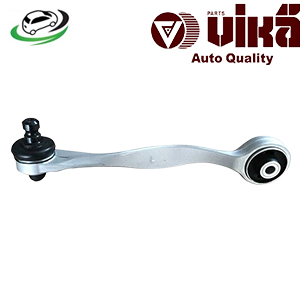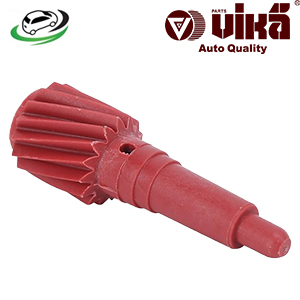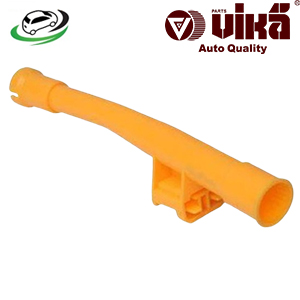-17%
Get Engine Oil Dipstick Funnel Audi B5 A4 FWD 1.8T/ Audi B5 A4 Quattro 1.8T/ VW Passat B5 4 Motion 1.8T/ Passat B5 FWD 1.8T 06B103663C
The engine oil dipstick funnel, while a seemingly simple tool, plays a critical role in the maintenance and operation of an engine. It is used to facilitate the accurate measurement and addition of engine oil, ensuring the engine remains well-lubricated and operates smoothly. This comprehensive overview will cover the design, function, importance, types, common issues, and maintenance of the engine oil dipstick funnel.
Design and Function
Design:
- Construction:
- Material: Engine oil dipstick funnels are typically made from durable, heat-resistant materials such as plastic or metal. Plastic funnels are lightweight and resistant to corrosion, while metal funnels may offer enhanced durability and heat resistance.
- Shape and Structure: The funnel has a conical or tapered shape that allows it to fit snugly into the dipstick tube or oil fill opening. The wide opening at the top allows for easy pouring of oil, while the narrow spout directs the oil flow into the engine.
- Placement:
- Dipstick Tube: The funnel is inserted into the dipstick tube to channel oil into the engine. This tube is a designated entry point for adding oil and is typically located near the engine’s oil fill cap.
- Oil Fill Opening: Some engines have a separate oil fill opening, where the funnel can be used to pour oil directly into the engine. This is common in engines that have a separate fill port from the dipstick tube.
Functionality:
- Accurate Oil Addition:
- Guiding Oil Flow: The funnel ensures that oil is directed precisely into the engine, reducing the risk of spills or leaks. This helps maintain the correct oil level and ensures proper engine lubrication.
- Preventing Contamination: By providing a controlled flow path, the funnel minimizes the risk of contaminants entering the engine oil, which could lead to engine damage or reduced performance.
- Ease of Use:
- Convenience: The funnel simplifies the process of adding oil, making it easier for vehicle owners and technicians to perform oil changes or top-ups. Its design allows for a mess-free and efficient oil addition process.
- Accessibility: The funnel’s shape and size make it easy to access the dipstick tube or oil fill opening, even in cramped engine compartments.
Importance of the Engine Oil Dipstick Funnel
- Engine Lubrication:
- Maintaining Oil Levels: The primary importance of the funnel is to ensure that the engine receives the correct amount of oil. Proper lubrication is essential for reducing friction between engine components, preventing wear, and maintaining engine performance.
- Preventing Damage: Adequate oil levels help prevent engine damage due to insufficient lubrication. The funnel helps ensure that oil is added accurately, reducing the risk of engine damage or failure.
- Efficient Oil Changes:
- Smooth Operation: During an oil change, the funnel facilitates the transfer of oil from the container to the engine, ensuring that the oil is added efficiently and without spillage.
- Reducing Mess: The funnel’s design helps contain the oil flow, minimizing mess and making the oil change process cleaner and more efficient.
- Engine Health and Longevity:
- Optimal Performance: Regularly adding the correct amount of oil is crucial for maintaining engine health and performance. The funnel aids in achieving this by providing a controlled and accurate method for oil addition.
- Preventing Contamination: By directing oil flow cleanly into the engine, the funnel helps prevent contaminants from entering the oil, which can affect engine longevity and performance.
Types of Engine Oil Dipstick Funnels
- Standard Funnels:
- Design: Standard engine oil dipstick funnels are basic, conical funnels designed for general use. They typically feature a wide opening for pouring oil and a tapered spout for directing the flow.
- Application: These funnels are suitable for most vehicles and engines and offer a cost-effective solution for oil addition.
- Flexible Funnels:
- Design: Flexible engine oil funnels are made from pliable materials that allow them to bend and conform to different shapes. This flexibility enables easier access to hard-to-reach areas and tight engine compartments.
- Application: Flexible funnels are ideal for vehicles with restricted access points or for situations where precise positioning is required.
- Metal Funnels:
- Design: Metal engine oil funnels are typically made from aluminum or stainless steel. They offer enhanced durability and heat resistance compared to plastic funnels.
- Application: Metal funnels are suitable for professional use or for environments where durability and resistance to high temperatures are important.
- Funnels with Built-in Filters:
- Design: Some funnels come with built-in filters or screens that capture debris or contaminants before they enter the engine. This helps ensure that only clean oil is added to the engine.
- Application: Funnels with built-in filters are useful for maintaining engine cleanliness and preventing contamination during oil changes or top-ups.
Common Issues with Engine Oil Dipstick Funnels
- Clogging:
- Causes: Oil can become thick or sticky, leading to clogging of the funnel’s spout. Debris or contaminants may also accumulate and block the flow of oil.
- Signs: Signs of clogging include slow or obstructed oil flow, difficulty pouring oil, and potential spills or overflows.
- Spills and Mess:
- Causes: Improper use or a poorly designed funnel can lead to spills or messes during oil addition. Overfilling or improper positioning can also result in spills.
- Signs: Signs of spills include oil drips or puddles around the engine, stains on the vehicle or garage floor, and a messy oil change area.
- Wear and Tear:
- Causes: Frequent use, exposure to oil, and cleaning can cause wear and tear on the funnel. Plastic funnels may become brittle or cracked over time, while metal funnels may develop rust or corrosion.
- Signs: Signs of wear and tear include cracks or damage to the funnel, difficulty in maintaining a secure connection, and reduced effectiveness in directing oil flow.
- Compatibility Issues:
- Causes: Funnels may not fit properly into certain dipstick tubes or oil fill openings, leading to leaks or difficulty in pouring oil. Incorrect funnel size or shape can also cause problems.
- Signs: Signs of compatibility issues include difficulty inserting the funnel, leaks or spills around the funnel, and inefficient oil flow.
Maintenance and Inspection
- Regular Cleaning:
- Clean After Use: After each use, clean the funnel thoroughly to remove any residual oil or debris. This helps prevent contamination and maintains the funnel’s effectiveness.
- Inspect for Damage: Regularly inspect the funnel for signs of wear or damage. Look for cracks, corrosion, or clogging that may affect its performance.
- Proper Storage:
- Store in a Clean Area: Store the funnel in a clean, dry area to prevent contamination and damage. Avoid exposing it to harsh chemicals or extreme temperatures that could affect its material.
- Keep Away from Contaminants: Ensure that the funnel is kept away from any substances that could contaminate the oil, such as dirt or debris.
- Replacement:
- Replace When Necessary: Replace the funnel if it becomes damaged, clogged, or worn out. Using a damaged funnel can lead to spills, contamination, or inefficient oil addition.
- Choose Quality Parts: When replacing the funnel, choose a high-quality product that meets your needs and is compatible with your vehicle’s oil fill openings.
Using the Engine Oil Dipstick Funnel
- Preparation:
- Gather Tools: Before using the funnel, gather the necessary tools, including the funnel itself, engine oil, and any other items required for the oil change.
- Consult the Manual: Refer to the vehicle’s owner’s manual for specific instructions on the oil fill location and recommended oil type.
- Insert the Funnel:
- Position the Funnel: Insert the funnel into the dipstick tube or oil fill opening, ensuring a secure fit. Ensure that the funnel is properly aligned to direct oil flow into the engine.
- Check for Leaks: Ensure that there are no leaks around the funnel and that it is properly positioned to prevent spills.
- Add Oil:
- Pour Oil Slowly: Pour the engine oil slowly into the funnel, allowing it to flow smoothly into the engine. Avoid overfilling and monitor the oil level as you pour.
- Check Oil Level: After adding oil, check the engine oil level using the dipstick to ensure it is within the recommended range. Add more oil if necessary, and recheck the level.
- Remove and Clean the Funnel:
- Remove the Funnel: Once the oil has been added, carefully remove the funnel from the dipstick tube or oil fill opening. Ensure that any residual oil is contained and does not spill.
- Clean the Funnel: Clean the funnel thoroughly after use to remove any remaining oil or debris. Store it properly to maintain its condition and effectiveness.
Follow us on Facebook for more parts.



